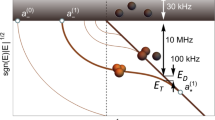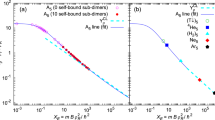Abstract
The Efimov effect in heteronuclear cold atomic systems is experimentally more easily accessible than the Efimov effect for identical atoms, because of the potentially smaller scaling factor. We focus on the case of two or three heavy identical bosons and another atom. The former case was recently observed in a mixture of \(^{133}\hbox {Cs}\) and \(^6\hbox {Li}\) atoms. We employ the Gaussian Expansion Method as developed by Hiyama, Kino et al. (Prog Part Nucl Phys 51:223–307, 2003). This is a variational method that uses Gaussians that are distributed geometrically over a chosen range. Supplemental calculations are performed using the Skorniakov–Ter- Martirosian equation. Blume et al. (Phys Rev Lett 113:213201, 2014) previously investigated the scaling properties of heteronuclear systems in the unitary limit and at the three-body breakup threshold. We have completed this picture by calculating the behaviour on the positive scattering length side of the Efimov plot, focussing on the dimer threshold.
Similar content being viewed by others
References
D. Blume, Y. Yan, Generalized Efimov scenario for heavy-light mixtures. Phys. Rev. Lett. 113, 213201 (2014)
E. Braaten, H.W. Hammer, Universality in few-body systems with large scattering length. Phys. Rep. 428, 259–390 (2006)
A. Deltuva, Properties of universal bosonic tetramers. Few Body Syst. 54, 569–577 (2013)
V. Efimov, Energy levels arising from resonant two-body forces in a three-body system. Phys. Lett. B 33, 563–564 (1970)
H.W. Hammer, L. Platter, Universal properties of the four-body system with large scattering length. Eur. Phys. J. A 32, 113–120 (2007)
K. Helfrich, H.W. Hammer, D.S. Petrov, Three-body problem in heteronuclear mixtures with resonant interspecies interaction. Phys. Rev. A 81, 042715 (2010)
E. Hiyama, Y. Kino, M. Kamimura, Gaussian expansion method for few-body systems. Prog. Part Nucl. Phys. 51, 223–307 (2003)
J. von Stecher, J.P. D’Incao, C.H. Greene, Signatures of universal four-body phenomena and their relation to the Efimov effect. Nat. Phys. 5, 417–421 (2009)
Y. Wang, W.B. Laing, J. von Stecher, B.D. Esry, Efimov physics in heteronuclear four-body systems. Phys. Rev. Lett. 108, 073201 (2012)
Author information
Authors and Affiliations
Corresponding author
Additional information
This article belongs to the special issue “The 23rd European Conference on Few-Body Problems in Physics”.
Rights and permissions
About this article
Cite this article
Schmickler, C.H., Hammer, HW. & Hiyama, E. Trimer and Tetramer Bound States in Heteronuclear Systems. Few-Body Syst 58, 22 (2017). https://doi.org/10.1007/s00601-016-1182-1
Received:
Accepted:
Published:
DOI: https://doi.org/10.1007/s00601-016-1182-1




